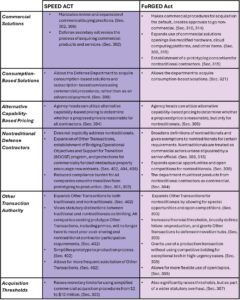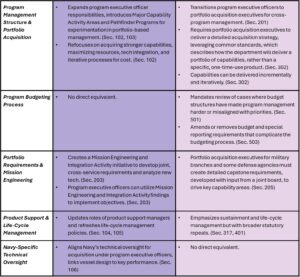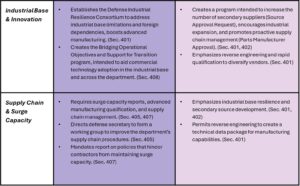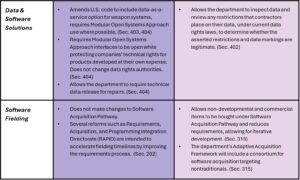Join War on the Rocks and gain access to content trusted by policymakers, military leaders, and strategic thinkers worldwide.


On June 9, House Armed Services Chair Mike Rogers and Ranking Member Adam Smith introduced H.R. 3838, the Streamlining Procurement for Effective Execution and Delivery (SPEED) Act. This is not the first piece of major defense legislation introduced in recent months. In December, Senate Armed Services Chair Roger Wicker introduced S.5618, the Fostering Reform and Government Efficiency in Defense Act (FoRGED) Act. The bills are likely to be reconciled when creating the National Defense Authorization Act.
These two bills encourage reforms in similar areas — the acquisitions system, the program-management model, requirements and regulatory burden, innovation and the industrial base, and software and data — but aim to accomplish these reforms in different ways. Read along for a side-by-side comparison of each plan.
Cogs of War is providing this comparison for those who will be forced to navigate the differences between the two and weigh in with the respective committees and their elected representatives.
Acquisition Reform
The most noteworthy sections of these bills attempt to address the fundamental issues plaguing acquisition processes. Both bills promote significant commercial solutions reform, including changes to transaction authorities, alternative capability-based pricing, and acquisition thresholds. Whereas the SPEED Act extends these reforms to all companies and is interpreted by some as more prime-friendly, the FoRGED Act places a particular emphasis on streamlining acquisition reform for commercial firms and nontraditional defense contractors.

Program and Portfolio Management
Both SPEED and FoRGED alter and expand the roles of program executives and staff, enabling a similar movement toward portfolio-centric management.

Innovation, the Industrial Base, and Supply Chains
Each piece of legislation promotes more resilient, innovative supply chains, with a strengthened industrial base. SPEED introduces several broad reforms, funding groups that address industrial base issues, whereas FoRGED focuses on expanding the number of secondary suppliers and permits reverse engineering.

Requirements Reform
Both SPEED and FoRGED emphasize data-driven decisions and greater alignment with operational needs, but differ in their approach to restructuring. SPEED creates new processes to enable more flexible requirements development and program termination, whereas FoRGED restructures existing organizations and focuses on removing statutory barriers to trade-offs.

Data and Software
Both bills attempt to make it easier for software and data-centric companies to do business with the government but follow different approaches. In SPEED, the data-as-a-service option allows the government to access and utilize privately held data without acquiring it and encourages quicker fielding of new technologies. FoRGED directly mandates the modernization of several software acquisition pathways, giving greater flexibility and speed in commercial contracting.

Regulatory Burden
There are thousands of sections of U.S. code and defense legislation that regulate defense acquisitions, and both FoRGED and SPEED take aim at them. SPEED focuses on the burdensome financial and commercial payments process, whereas FoRGED takes a more aggressive approach to requirements, mass-repealing legacy legislation and forming several new financial mechanisms to make it easier to do business with the Defense Department.

The Acquisitions Workforce
SPEED emphasizes its willingness to develop the current acquisitions and procurement workforce, with no equivalent legislation from FoRGED.

Madeline Field is the assistant editor of Cogs of War, a vertical at War on the Rocks focused on defense technology and the defense industrial base.
Image: Midjourney